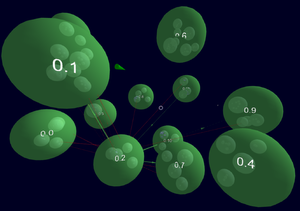Information
- Publication Type: Bachelor Thesis
- Workgroup(s)/Project(s):
- Date: April 2021
- Date (Start): September 2020
- Date (End): April 2021
- Matrikelnummer: 01633012
- First Supervisor: Manuela Waldner
- Second Supervisor: Johannes Sorger
Abstract
Our world is becoming more digital each year, new parts of our daily life become connected and the amount and complexity of the produced data increases steadily. The analysis of this data enables big opportunities for science and industry. A subset of this data is organized in the form of hierarchical networks or can be transformed by clustering algorithms into hierarchical layers. We see this in multiple application domains for example medical research where connections, group and cluster memberships of diseases are tracked; social science where relationships are mapped in company organization charts; in software engineering in the form of build-, dependency- and source code version management software with hierarchical connections between software modules, versions and layered software architecture.However, getting insight into this complex data with traditional two-dimensional visualization is getting more difficult as the visual clutter increases significantly with the exponentially growth of data we saw in recent years. Therefore, we need new methods and techniques to facilitate and expedite the analysis process. In this thesis, we investigate a new approach to visualize hierarchical network data by extending already existing concepts of two-dimensional hierarchical network visualizations with a third dimension and applying it to a virtual reality based visualization system. We believe that the capabilities of virtual reality devices, such as improved spatial impression and interaction possibilities by room-scale tracked headsets and controllers allow the visualization to fully utilize the benefits of three-dimensional information visualization. Therefore, it should be possible to analyze even bigger and more complex hierarchical networks than currently possible with conventional two-dimensional visualizations.
Additional Files and Images
Weblinks
BibTeX
@bachelorsthesis{eiweck-hnv-2021,
title = "Immersive Exploration of Hierarchical Networks in VR",
author = "Manuel Eiweck",
year = "2021",
abstract = "Our world is becoming more digital each year, new parts of
our daily life become connected and the amount and
complexity of the produced data increases steadily. The
analysis of this data enables big opportunities for science
and industry. A subset of this data is organized in the form
of hierarchical networks or can be transformed by clustering
algorithms into hierarchical layers. We see this in multiple
application domains for example medical research where
connections, group and cluster memberships of diseases are
tracked; social science where relationships are mapped in
company organization charts; in software engineering in the
form of build-, dependency- and source code version
management software with hierarchical connections between
software modules, versions and layered software
architecture. However, getting insight into this complex
data with traditional two-dimensional visualization is
getting more difficult as the visual clutter increases
significantly with the exponentially growth of data we saw
in recent years. Therefore, we need new methods and
techniques to facilitate and expedite the analysis process.
In this thesis, we investigate a new approach to visualize
hierarchical network data by extending already existing
concepts of two-dimensional hierarchical network
visualizations with a third dimension and applying it to a
virtual reality based visualization system. We believe that
the capabilities of virtual reality devices, such as
improved spatial impression and interaction possibilities by
room-scale tracked headsets and controllers allow the
visualization to fully utilize the benefits of
three-dimensional information visualization. Therefore, it
should be possible to analyze even bigger and more complex
hierarchical networks than currently possible with
conventional two-dimensional visualizations.",
month = apr,
address = "Favoritenstrasse 9-11/E193-02, A-1040 Vienna, Austria",
school = "Research Unit of Computer Graphics, Institute of Visual
Computing and Human-Centered Technology, Faculty of
Informatics, TU Wien ",
URL = "https://www.cg.tuwien.ac.at/research/publications/2021/eiweck-hnv-2021/",
}

 thesis
thesis

